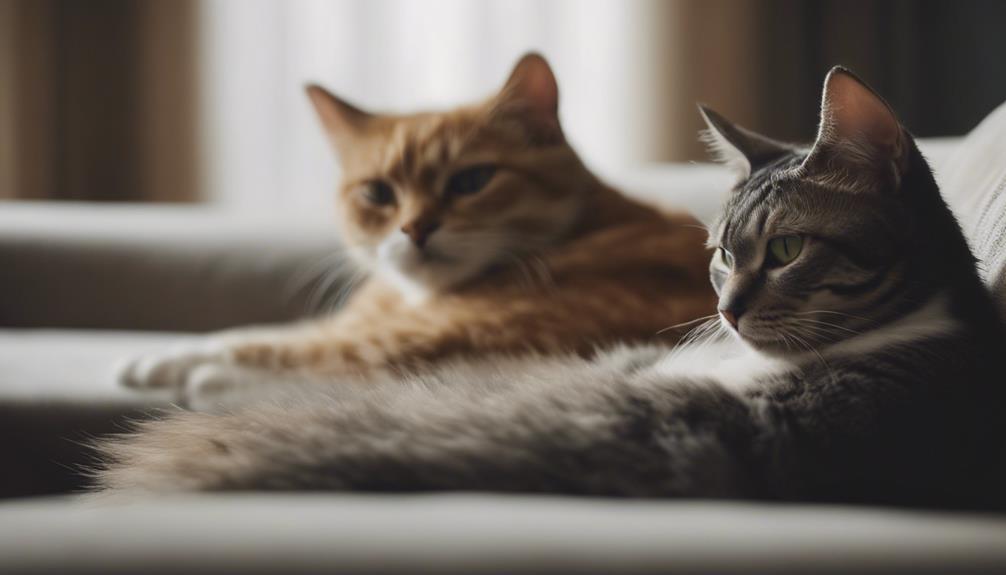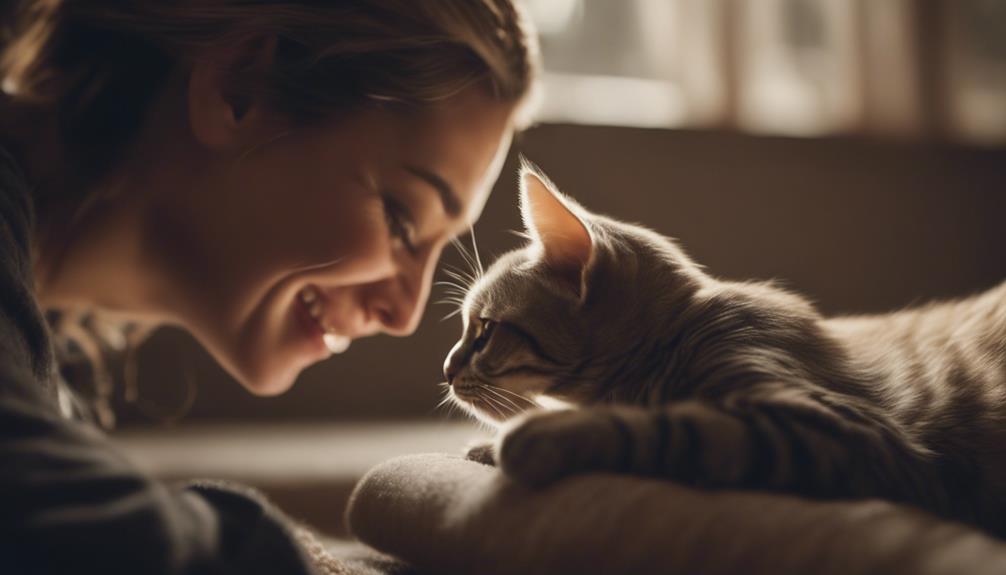Do Cats Socialize Differently With Humans Than With Other Cats?

Cats are solitary animals by nature and have a different social structure compared to pack animals like dogs. They form close bonds with their human caregivers, often seeking attention and affection. On the other hand, interactions with other cats are more likely to involve territorial behavior and establishing hierarchies within a group. Cats may display various forms of communication, such as purring, meowing, and body language, to interact with humans and other cats.
Cats may also exhibit different types of play behavior depending on their social partner. When interacting with humans, cats may engage in more interactive and playful behaviors, while interactions with other cats may involve more predatory or aggressive play. Ultimately, cats have the ability to adapt their social behaviors to suit the specific social context, whether it involves interacting with humans or other cats.
Understanding Cat Social Behavior
Examining cat social behavior reveals intricate patterns of interaction that shed light on their unique communication methods and social structures. Feline friendships play a crucial role in the social lives of cats. Cats form bonds with other cats based on factors such as familiarity, territory, and hierarchy. These relationships are often characterized by mutual grooming, play behavior, and sharing resting spaces. Understanding the dynamics of feline friendships can help individuals provide enriching environments for their cats, promoting their overall well-being.
Human-cat interactions differ significantly from feline friendships. While cats may form strong emotional bonds with their human caregivers, these relationships are influenced by factors such as trust, respect, and communication styles. Cats often exhibit distinct behaviors when interacting with humans, such as kneading, purring, and head-butting, which aren't commonly observed in their interactions with other cats. Recognizing these differences can enhance the quality of human-cat relationships and foster a deeper understanding of cats' social behavior.
Communication Styles: Cats Vs Humans

Comparatively, cats and humans employ distinct communication styles in their interactions, reflecting differing social dynamics and behavioral cues. Feline body language plays a crucial role in cat communication, with behaviors such as tail position, ear movements, and body postures conveying a range of emotions and intentions. Cats also use vocalizations, such as meowing, purring, hissing, and growling, to express their needs and feelings.
On the other hand, humans rely heavily on verbal communication and facial expressions to convey their thoughts and emotions, often using gestures to emphasize or clarify their messages. Understanding these differences in communication styles is essential for effective interaction between cats and humans. While cats may respond more favorably to feline body language and cues, humans can adapt by learning to interpret and respond to these signals appropriately.
Bonding With Feline Companions

Studying the behavioral patterns and social dynamics of cats can provide insights into fostering stronger bonds with feline companions. Understanding feline bonding rituals and human-cat interactions is essential for creating harmonious relationships with our beloved pets.
- Scent Exchange: Cats engage in scent-marking behaviors to establish familiarity and comfort within their environment and with their human companions. By allowing cats to interact with our scent through clothing or bedding, we can strengthen the bond between human and feline.
- Playtime: Interactive play sessions provide opportunities for bonding through shared activities and positive reinforcement. Engaging in play helps build trust and companionship between cats and their human caregivers.
- Routine and Consistency: Cats thrive on predictability and routine. Establishing a consistent schedule for feeding, play, and affectionate interactions can enhance the bond between cats and their owners.
- Respect for Boundaries: Recognizing and respecting a cat's need for personal space and alone time is crucial for fostering trust and strengthening the human-cat relationship. Understanding and honoring a cat's boundaries can lead to a more secure and affectionate bond.
Social Hierarchy in Cat Groups
Cats establish social hierarchies within groups to determine access to resources and breeding opportunities. Dominance dynamics play a crucial role in shaping these hierarchies, with certain cats asserting their authority over others through body language, vocalizations, and physical interactions.
Understanding the communication patterns within feline groups can provide insights into the intricate social structures that govern cat relationships.
Cat Dominance Dynamics
In group settings, feline social structures are characterized by intricate dominance dynamics, where individuals establish hierarchy through various behavioral cues and interactions. Understanding cat dominance dynamics can provide insights into the social hierarchies and feline interactions within a group.
When studying dominance in cats, researchers often focus on behaviors such as body language, vocalizations, and territorial marking. Dominant cats typically display confident body postures, vocalize less frequently, and mark their territory more extensively. Submissive individuals tend to exhibit more appeasement behaviors, avoid direct eye contact with dominant cats, and may groom higher-ranking individuals.
By observing and analyzing these behaviors, researchers can unravel the complex social dynamics present within cat groups.
- Body language plays a crucial role in dominance displays
- Vocalizations vary depending on an individual's rank
- Territorial marking is often linked to dominance
- Grooming behaviors reflect social hierarchy
Communication Within Feline Groups
Communication patterns within feline groups reflect the intricate social hierarchy established among individuals. In these groups, feline friendships and group dynamics play crucial roles in shaping interactions. Cats communicate within their groups through a variety of vocalizations, body language, and scent marking.
The hierarchy within the group influences how cats interact with each other, with dominant cats often displaying assertive behaviors towards subordinates. Submissive cats may use body postures like crouching or avoiding direct eye contact to show deference to higher-ranking individuals. Understanding these communication cues is essential in deciphering the complex interactions within feline groups.
Play and Interaction: Cats' Preferences

Cats exhibit distinct preferences in play and interaction based on whether they're engaging with humans or other cats.
Differences in communication styles and play behaviors are often observed when comparing cat-human interactions to cat-cat interactions.
Understanding these preferences can provide insight into the social dynamics of cats in various environments.
Cat-Human Vs Cat-Cat Play
When considering play and interaction preferences, cats exhibit distinct behaviors in their interactions with humans compared to interactions with other cats. Cats engage in play dynamics differently based on the species they interact with, showing unique preferences for each type of interaction.
Key observations include:
- Human Involvement: Cats often display more varied and complex play behaviors when interacting with humans.
- Socialization Dynamics: Cats may show more independence and less reliance on social cues when playing with other cats.
- Interspecies Interactions: Cats tend to adjust their play style based on the species they're interacting with, showing a level of adaptability.
- Communication Cues: Cats may use different communication signals when engaging in play with humans versus other cats.
Communication Differences Observed
In interactions with different species, cats demonstrate nuanced variations in their behavioral responses during play and social engagement. When engaging with humans, cats often exhibit subtle differences in their communication methods compared to interactions with other felines. Cats may rely more on vocalizations, such as meowing or purring, to communicate their needs and preferences to humans.
Additionally, they might display more body language cues, like rubbing against their human companions or kneading with their paws, to show affection or seek attention. On the other hand, when interacting with fellow cats, social grooming and scent marking play a more significant role in communication. These variations highlight cats' adaptability in utilizing different communication strategies based on the species they're engaging with.
Challenges in Multispecies Household

Living in a household with multiple species can present various challenges that may impact the social dynamics between pets. Behavioral challenges and multispecies dynamics play a crucial role in understanding the complexities of interactions between different animals sharing the same living space.
- Resource Competition: Different species may compete for limited resources such as food, water, or attention, leading to potential conflicts.
- Communication Barriers: Varied communication styles among species can result in misunderstandings and difficulty in establishing clear boundaries.
- Hierarchical Struggles: Dominance hierarchies may differ between species, potentially causing tension and power struggles within the household.
- Stress and Anxiety: The presence of multiple species can create a stressful environment for some pets, affecting their overall well-being and behavior.
Addressing these challenges requires a deep understanding of each species' natural behavior, proper environmental enrichment, and strategic management techniques to foster harmonious relationships in multispecies households.
Tips for Enhancing Cat Relationships

Implementing consistent positive reinforcement techniques can significantly enhance the relationships between cats in a multi-cat household. Enrichment activities play a crucial role in improving cat behavior and fostering positive interactions among feline companions. Providing interactive toys, puzzle feeders, and vertical spaces for climbing can help reduce tension and promote mental stimulation, leading to happier and more content cats.
Building trust is essential for strengthening cat companionship within a multi-cat environment. Creating separate feeding stations and offering individual attention during playtime can help prevent competition and promote a sense of security among cats. Additionally, establishing a predictable routine for feeding, grooming, and play sessions can contribute to a harmonious coexistence among feline housemates.
Understanding cat behavior cues, such as body language and vocalizations, is vital for effective communication and conflict resolution between cats. By recognizing signs of distress or discomfort, pet owners can intervene early to prevent potential conflicts and maintain a peaceful cohabitation. Overall, implementing these tips for enhancing cat relationships can lead to a more harmonious and fulfilling environment for all feline residents.
Frequently Asked Questions
Can Cats Form Strong Bonds With Both Humans and Other Cats at the Same Time?
Cats can indeed form strong bonds with both humans and other cats simultaneously. These dual relationships showcase the versatility of feline friendships, demonstrating their ability to navigate and thrive within diverse social dynamics.
Do Cats Have a Preference for Socializing With Humans Over Other Cats, or Vice Versa?
When it comes to social hierarchy, cats may exhibit preferences for human interactions over those with other cats due to environmental influences. Understanding feline behavior in varied contexts can shed light on these dynamics.
How Do Cats Communicate Differently With Humans Compared to Other Cats?
Cats communicate with humans and other cats through body language, vocal cues, play behavior, and grooming habits. They adapt their signals based on the recipient, using purrs, meows, tail movements, and physical interactions to convey messages effectively.
Can a Cat's Social Behavior Change Depending on the Environment or Situation They Are In?
Environmental influences can alter a cat's social behavior, affecting how they interact with others. Situational changes, such as new surroundings or the presence of other cats, can impact a cat's social interactions, highlighting their adaptability in various settings.
Are There Any Specific Behaviors or Cues That Cats Use to Show They Prefer One Type of Social Interaction Over Another?
Cats communicate preferences through body language cues and vocalization differences. They establish social hierarchy dynamics and exhibit territorial behavior. Understanding these signals is key to interpreting a cat's desired social interaction, whether with humans or other cats.











